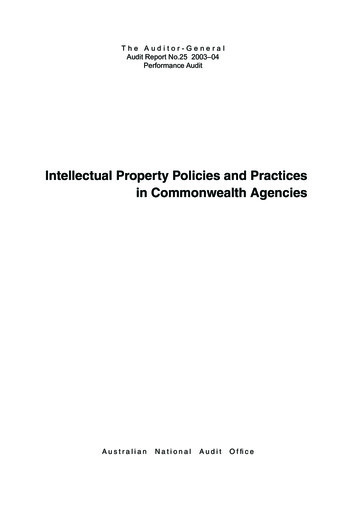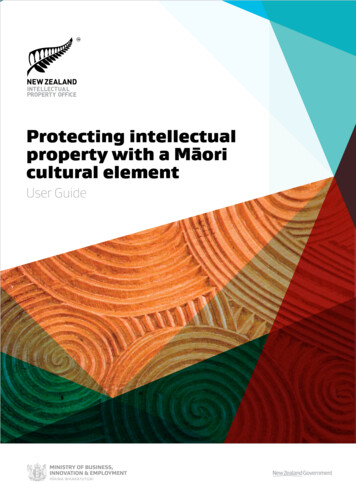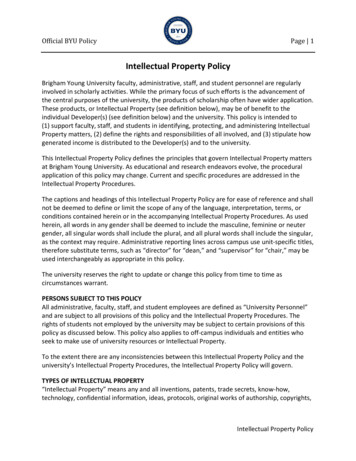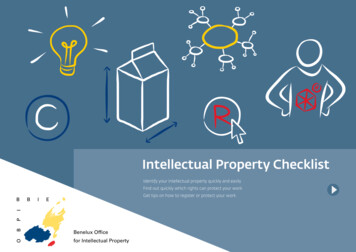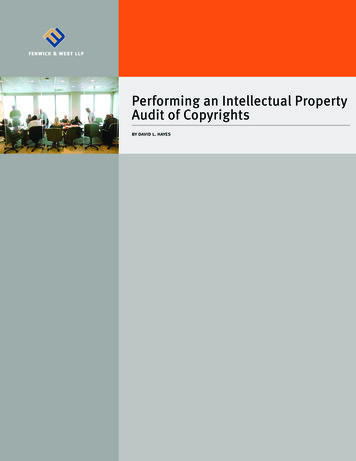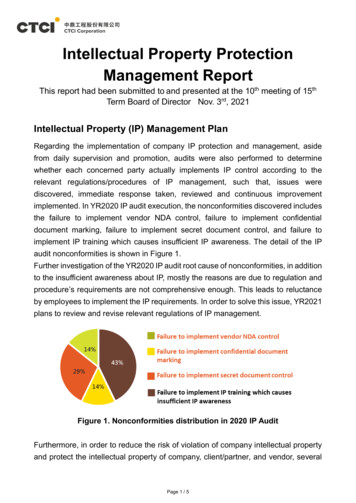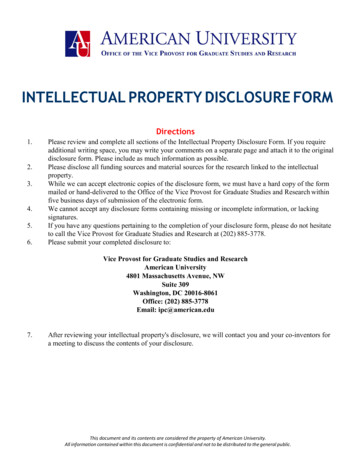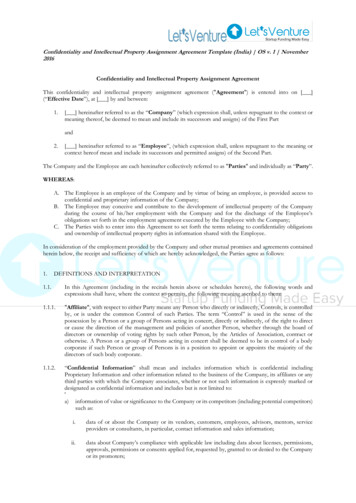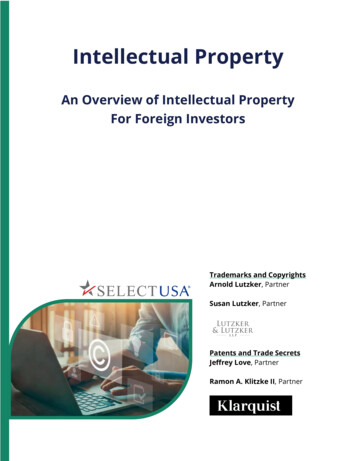
Transcription
Intellectual PropertyAn Overview of Intellectual PropertyFor Foreign InvestorsTrademarks and CopyrightsArnold Lutzker, PartnerSusan Lutzker, PartnerPatents and Trade SecretsJeffrey Love, PartnerRamon A. Klitzke II, Partner
INTELLECTUAL PROPERTYIntroduction to Intellectual Property (IP) for Foreign InvestorsFor foreign investors, like other business owners, the most valuable assets of abusiness are its Intellectual Property (IP). The heart of the IP are four categories ofassets: trademarks, copyrights, patents, and trade secrets. Each of these assets isthe basis upon which a business is built and thrives. All four categories have unique legalsystems that invest ownership in the creator and enable lawful control and exploitation.Generally, IP is managed on a national basis, with a common set of international principlesdeveloped over more than a century of bilateral and multilateral treaties.For all creators, protection starts in one’s home country and then extends to the target offoreign investment, which is the United States for the purposes of this chapter. Therefore,foreign investors should always start by first protecting their IP in their home country.Then, once a decision is made to conduct business in the United States, the investors needto take effective steps to protect their IP in the United States.The U.S. legal system provides one of themost expansive sets of protections for IPassets of any nation. It starts with core,constitutional principles, which are clarifiedand implemented by federal and statestatutes, administrative regulations, andjudicial determinations. Some IP, liketrademarks and patents, should beidentified, cleared as available for exclusiveownership, and protected as early as possible. Other IP, like copyrights and trade secrets,once created, should be protected formally, by registration or contract. Failure to analyzethe availability of IP assets for exclusive ownership and to secure full legal protections canplace in jeopardy both the assets and the financial investment made to create them.In the United States, there are limitless options to promote and utilize an investor’s productvia sale and licensing through traditional channels, online, and through apps. When itcomes time to seek additional capital or sell a company, IP assets are the bedrock of thebusiness’s value. Protecting an investor’s IP and enforcing subsequent rights againstinfringers requires knowledge of the applicable laws and the ability to react quickly to anever-changing landscape. This is a basic guide for all foreign investors.Trademarks and ServicemarksWhat Is a Trademark/Servicemark?Trademarks (for goods) and servicemarks (for services) are the words, phrases, symbols,designs, product configurations, and even colors and smells, that stand for a business in1
INTELLECTUAL PROPERTYthe eyes of the consumer and in the minds of competitors. They are the shorthandexpression that defines the goodwill a company has built over time. The central basis fortrademark protection in the United States is “use in commerce,” and the law protectsagainst the “likelihood of confusion” between a business’s mark and a competitor’s mark.Trademark rights are exclusive to the proprietor; therefore, it is critical that a businessprotects its brand as soon as plans to enter the United States are formalized.How Do Investors Protect Their Trademarks?In the United States, there are both state (local) and federal (national) ways of protecting atrademark. On the local level, merely using a mark gains common law rights and enables abusiness to carve out protection in the state or states where it operates. An investor canalso register a trademark with the state-level Secretary of State (not to be confused withthe federal role of the same name). However, common law/state protection will notnecessarily prevent someone in a distant state from using the same mark competitively. Tobest protect against this challenge, investors should plan to secure federal rights and takeadvantage of the benefits of registering with the U.S. Patent and Trademark Office (USPTO).Federal rights are protected under the Lanham Act (15 USC §1051 et seq.), which is thefederal trademark statute.The USPTO offers two options for trademark owners. First, before a business begins use,the company can claim a mark by filing an “Intention to Use” application (ITU). An ITU filingcan be submitted even before entering the U.S. market, and it is strongly recommended.The ITU is a formal reservation of rights to the mark, which, once allowed by the USPTO,must be perfected by using the mark incommerce. Critically, if someone else(Company B) uses the same mark for thefirst time after another company’s(Company A’s) ITU filing, the originalcompany (Company A) can force them tostop that use. However, without the filing,the original company’s (Company A’s) markmay be restricted instead.Second, if a company has not filed an ITU, but its mark is in use in the United States, thecompany can submit a standard application. While not required to secure common lawtrademark rights, the importance of filing and securing federal registration cannot beoverstated. Once a mark is registered, it acquires national protection, and the trademarkowner has a virtual monopoly on the right to use the mark for those products or services.That monopoly can be enforced in any federal court in the United States. Also, byinternational treaties, a registrant can extend protection to other countries.2
INTELLECTUAL PROPERTYHow Should Investors Select a Trademark for Their Business?If a company has a brand in its home market or is selecting a new mark for its U.S.business, the company should strive to develop a distinctive mark that will stand up againstcompetitors. The hallmark legal issue in trademark law is “likelihood of confusion,” so acompany should have a mark that will withstand a claim that it confuses the consumer asto the source of the good or service.Additionally, trademarks can be characterized by their strength in the public’s mind asfollows (from strongest and most protectable to weakest or not protectable): Fanciful marks: these have no dictionary meaning or connection with the business,like Qorvo for technology or radio frequency solutions. Arbitrary marks: these are dictionary words but have no connection to the goods orservices, like Apple for computers. Suggestive marks: these creatively hint at a feature of the goods or services, likeFederal Express for national overnight package delivery. Descriptive marks: these describe a feature of the good or service, and some areprotectable, some not. If, with the investment of time and money, the mark gainspublic recognition and stands as a unique source, like ChapStick for lip balm, it canbe exclusively owned; however, if the description is needed by all competitors todescribe the product, like “sun block” for sunscreen, it is not protectable. Generic terms: these are not trademarks but rather words or phrases that stand forthe genus of the product or service, like dry ice or cell phone.To avoid investing in a brand that would later have to be abandoned (or leave a companyvulnerable to charges of infringing another’s mark), businesses should conduct a search todetermine the availability of the mark in the United States and be assured that it would notcreate a likelihood of confusion with another’s mark. Searches can be cursory or detailed,and the extent of a search depends on such factors as where the mark fits on the strengthcontinuum and how much will be invested to promote the brand. Because of theimportance of the internet to marketing, you should also quickly secure the mark’s domainname as well.How Does a Business Get Federal Protection for Its Trademark?Once a mark is “cleared,” the next step is to file an application with the USPTO. It isimportant to file an ITU application before a company commences business in the UnitedStates, as well as a standard application once use in the United States commences. Thereare also treaties, such as the Paris Convention, which allow a foreign entity to claim U.S.3
INTELLECTUAL PROPERTYtrademark rights based on first use at home. All options for registration should be carefullyconsidered.The time between filing an application and registration can vary, but typically the processtakes about a year. An Examining Attorney reviews the application for technical formalitiesand to assess whether the mark applied for is confusingly similar to a registered mark. Animportant note for foreign investors: the Examining Attorney will translate foreign words toassess the meaning and “strength” of the mark.A letter or “office action” informs the applicant of any issues and must be answered withinsix months. If approved, the mark is published in the USPTO’s Official Gazette, which allowsfor public comment, including opposition. Assuming no challenge, the application willproceed to registration or, for ITUs, to allowance. Marks allowed by ITU must be in usewithin three years. A registration is granted for ten years and may be renewed indefinitelyas long as it is in use. Nevertheless, every registered owner must file an affidavit ofcontinued use in the fifth year after initial registration to get the full ten-year benefit.Failure to file that affidavit will result in registration being canceled. Before registration, atrademark owner can use the informal symbol TM adjacent to the mark to indicate atrademark claim. Once the mark is registered (and only after registration), an owner shouldadopt the statutory notice symbol, .Special considerations apply to trademarks that might be considered disparaging in theUnited States or that involve federally banned products (such as cannabis), so early legalhelp is essential for producers in these cases.How Does a Business Protect Its Trademark After Registration?Once a mark is registered, it is important to monitor the marketplace to identify any thirdparty uses that may create confusion. Failure to monitor a trademark and to act oninfringements can create cracks in a company’s IP claims and open the brand to a claim ofabandonment. Trademark “watch services” help monitor USPTO records and provide theopportunity to intervene early to protect a mark.CopyrightsWhat Is a Copyright?Copyright is a bundle of exclusive rights that is accorded authors of creative works, such asmovies, books, music, software, or photos. A copyrighted work must be original; have amodicum of creativity; and be fixed in a tangible medium of expression. The law protectsexpressions, but not facts or ideas, which are an essential part of free speech and the flowof information.4
INTELLECTUAL PROPERTYThe U.S. Constitution (Article I, Section 8, Clause 8) empowers Congress to grant to“authors” the exclusive right to their writings “for limited times.” This power is implementedthrough the Copyright Act, 17 USC §101 et seq. Through copyright law reform, the “limitedtimes” has been extended to nearly a century. Once the term of copyright expires, the workfalls into the public domain, which means that it is free to be copied and used by anyonewithout prior approval.The exclusive rights granted to a copyrightowner are these: the right to reproduce(copy) the work; the right to preparederivative works based on the original; theright to distribute copies to the public; theright to perform the work publicly; the rightto display the work publicly; and the right toperform sound recordings publicly bymeans of digital audio transmission. Theserights can be sold, licensed, loaned, or givenaway and can pass from one generation to the next.Importantly, copyright law balances the grant of exclusive rights to owners with a set oflimitations designed to permit certain public uses either without consent or subject to acompulsory license. The most prominent limitation is fair use, which defends against acharge of copyright infringement by establishing that the use is permitted, for purposessuch as criticism, comment, news reporting, teaching, scholarship, or research. Fair use andother limitations, as well as the compulsory licenses for software and music, are complexand require careful analysis to assure compliance with the statutory requirements.How Does a Business Protect Its Copyrights?Copyright rights attach to a work as soon as it is fixed in a tangible form. By treaty (TheBerne Convention), there are no “formalities” needed to gain rights; however, federalregistration and copyright notice ( NAME and YEAR CREATED), while not mandatory, areessential to enjoy full rights available to copyright owners in the United States. Before filinga case for infringement, the copyright must be registered. If the work is registered beforeinfringement, the U.S. system provides for recovery of actual losses, or alternativelyminimum statutory damages ( 750- 30,000 per work up to 150,000 in cases of willfulinfringement), plus recovery of reasonable attorneys’ fees. Criminal penalties are possiblefor certain types of willful copyright infringement. Copyright registration is a simpler andless expensive process than trademark registration. For certain classes of works (such asphotographs), group registrations are possible. Further, there are special procedures whenregistering software programs to maintain trade secrets embodied in code.5
INTELLECTUAL PROPERTYWhat is the Digital Millennium Copyright Act (DMCA)?In 1998, copyright law entered the internet’s digital age with the adoption of the DMCA. TheDMCA is an elaborate set of rules dealing with content online; content shared by websitesand online service providers (OSPs); and protection of copyright management information.Registration of a DMCA agent with the U.S. Copyright Office is now advisable for OSPs andinteractive websites. Given the importance and ubiquity of online websites for businessestoday, entities entering the U.S. market should learn and follow DMCA rules of the digitalroad.What is a Work for Hire Agreement?If an employee creates materials for their company within the scope of their employment,the employer owns the copyright. However, if an independent contractor (for example, asoftware engineer or a website designer) creates materials that fall within certain statutorycategories (for example, a contribution to a collective work or a motion picture), thenunless there is a written “work made for hire” agreement that defines ownership, thecontractor may claim copyright. In short, absent specific work for hire language appearingin a written contract, a business risks discovering it does not own clear title to thecopyrights it paid for and needs to succeed. If the materials created fall outside thestatutory categories, then a written assignment of copyright is required. In any event, awritten assignment is an advisable back up to a “work made for hire” provision.PatentsWhat Is A Patent?The United States Constitution grants Congress the power “To promote the progress ofscience and useful arts, by securing for limited times to authors and inventors the exclusiveright to their respective writings and discoveries.” (Article I, Section 8, Clause 8.) Pursuant tothat grant, Congress has enacted patent laws, and created a patent office that issuespatents to inventors. A patent is a document granting an inventor, or the inventor’sassignee, the right for a limited time (currently about 20 years from the date the patentapplication was filed) to file a complaint in federal court seeking a reasonable royalty andother compensation and relief, including an injunction, against persons and companiespracticing the patented invention without authorization, and to file a complaint with theU.S. International Trade Commission for an order barring the importation of goods thatinfringe the patent.Who Can Get A Patent?Inventors can get patents on their inventions. Assignees of inventors can get patents on theinventors’ inventions. U.S. patent law authorizes inventors to transfer to any person or6
INTELLECTUAL PROPERTYcompany, by written assignment, their rights to patent their inventions, and their rights toany patents already issued. The law provides: “Applications for patent, patents, or anyinterest therein, shall be assignable in law by an instrument in writing.” (35 USC § 261.) Inaccordance with that law, employees often assign in writing their patent rights to theiremployers.In some states within the United States, and some countries outside the United States,statutes provide that employers own any patentable inventions made by their employeesas part of their employment. For example, Nevada Revised Statute 600.500 provides that“an employer is the sole owner of any patentable invention or trade secret developed byhis or her employee during the course and scope of the employment that relates directly towork .” (N.R.S. 600.500).How Does One Get A Patent?For employers, start by obtaining in advance from employees a written assignment of anyemployee inventions and a written nondisclosure agreement obligating them to keepcompany inventions confidential.Then, identify potential inventions. Many companies create incentives for employees tocreate inventions, identify them as potentially valuable, and submit summaries of them tomanagement. These companies also create systems for management to regularly reviewthe summaries and determine whether they merit a patent application. Patent lawyersoften assist individuals and companies in identifying and evaluating potentially patentableinventions, obtaining written assignments of inventions from employees, and creatingsystems for receiving and reviewing invention summaries from employees.After a potential invention is identified,keep it confidential, and do not sellproducts embodying it, until anapplication to patent it is filed or adecision is made to not patent it.Nondisclosure agreements can help keepinventions confidential. Public disclosureof the invention (for example in articles orpresentations or in sales of productsembodying the invention) prior to thefiling of an application can result in the loss of patent rights. Patent lawyers routinely adviseindividuals and companies on how to keep potentially patentable inventions confidentialand when to file a patent application.Finally, file a patent application with the USPTO and prosecute the application throughissuance of the patent. Often it is best to file an initial patent application early, to preserve7
INTELLECTUAL PROPERTYrights in the invention as initially conceived, and then file a second application later afterthe invention has been more fully developed. Patent rights generally may extend for up to20 years from the filing of the application.Why Get A Patent?Patents can keep out competition over use of one’s patented inventions and providegrounds for seeking a reasonable royalty for use of the inventions, for the life of thepatents. If an invention that gives a significant competitive advantage is patented, or apatent application is pending, potential competitors may decide not to copy it to avoid therisks of patent litigation. If they do copy it, a successful patent lawsuit may result in a courtorder prohibiting further copying for the life of the patent; awarding a reasonable royalty;or, in some cases, lost profits and treble damages.Patents are valuable assets that increase the sale value of a company and its product lines.Potential purchasers of a company or product line often expect the company’s products tobe protected from wholesale copying by competitors by a substantial patent portfolio.Patents can be valuable assets in negotiating cross-license agreements with competitors.Patents can be a valuable source of income through licensing, litigation, and sale of thepatents. The process of identifying, keeping confidential, and seeking to patent inventionscan provide a company with incentives to be more inventive.What Can Be Patented?U.S. law provides for three different types of patents: a utility patent, design patent, andplant patent. These patents cover three distinct types of patentable subject matter: Utility Patent: “Whoever invents or discovers any new and useful process, machine,manufacture, or composition of matter, or any new and useful improvementthereof, may obtain a patent therefor ” (35 USC § 101); Design Patent: “Whoever invents any new, original and ornamental design for anarticle of manufacture may obtain a patent therefor .” (35 USC § 171); Plant Patent: “Whoever invents or discovers and asexually reproduces any distinctand new variety of plant may obtain a patent therefor .” (35 USC § 161).The U.S. Supreme Court has placed some limits on patentable subject matter, holding thatlaws of nature, physical phenomena, and abstract ideas are not patentable. (Diamond v.Chakrabarty, 447 U.S. 303 (1980).) Patent lawyers advise businesses on which of theirinventions and discoveries are patentable and the best type of patent protection to seekfor them.8
INTELLECTUAL PROPERTYTrade SecretsWhat Is A Trade Secret?A trade secret is information that is (a) valuable in a trade or business, (b) secret, and (c)protected by the owner’s reasonable steps to keep it secret. The federal Defend TradeSecrets Act of 2016 (DTSA) defines “trade secret” as follows (18 U.S.C. § 1839(3)):“the term ‘trade secret’ means all forms and types of financial, business, scientific,technical, economic, or engineering information, if—(A) the owner thereof has taken reasonable measures to keep such information secret; and(B) the information derives independent economic value, actual or potential, from notbeing generally known to, and not being readily ascertainable through proper means by,another person who can obtain economic value from the disclosure or use of theinformation; ”The Uniform Trade Secrets Act (UTSA) defines “trade secret” similarly (Section 1(4)):“(4) ‘Trade secret’ means information that:(i) derives independent economic value, actual or potential, from not being generallyknown to, and not being readily ascertainable by proper means by, other persons who canobtain economic value from its disclosure or use, and(ii) is the subject of efforts that are reasonable under the circumstances to maintain itssecrecy.”Who Can Own A Trade Secret?Anyone can own a trade secret. Anyone who develops the trade secret, or obtainsknowledge of it by proper means, may own it. Trade secrets may be acquired by writtenassignment. For example, part of the acquisition of a company or its assets often includes awritten assignment of trade secrets. Employers often require employees to assign to theiremployer in advance trade secrets they develop or discover during their employment.Some states and countries have statutes that provide that trade secrets discovered byemployees are owned by their employers.How Does One Protect A Trade Secret?As with patents, employers can start by obtaining in advance from employees a writtenassignment of any trade secrets developed or discovered by employees and a writtennondisclosure agreement obligating them to keep company trade secrets confidential.9
INTELLECTUAL PROPERTYThen, companies identify potential trade secrets. A company can offer incentives foremployees to identify potentially valuable trade secrets and put in place systems formanagement to regularly review and determine whether they merit special protection.When a company identifies a potential trade secret, it should keep it confidential. Publicdisclosure of the trade secret can result in the loss of legal rights for the secret.Unlike patents, there is no government office for submitting trade secrets for approval orprotection. The owner of the trade secret maintains legal rights in it by taking reasonablesteps to keep the information secret. These steps may include labelling documents “secret,”segregating them from ordinary business information in a secure location, such as a safeor password-protected computer in a locked room, requiring people with access to theinformation to sign nondisclosure agreements, minimizing the number of copies ofdocuments that contain the secret, and promptly taking steps to minimize any publicdisclosure of the secrets.Why Make the Effort to Maintain Information as Trade Secrets?For valuable information that is not generally known, establishing them as trade secrets bytaking reasonable steps to maintain their secrecy gives them substantial protection underboth state and federal laws throughout the United States. Since 1981, almost all stateshave enacted a version of the UTSA, which is a model Act drafted in 1979 (and amended in1985) by the Uniform Law Commission, a state-supported organization of lawyersestablished in 1892 to provide states with non-partisan model laws.In 2016, the federal government enacted the DTSA (18 U.S. Code § 1836). It is based on theUTSA, but with some changes. It provides a single law against theft of trade secrets relatedto a product or service used in interstate or foreign commerce. The DTSA appliesthroughout the United States; can apply to some trade secret theft outside the UnitedStates; can be enforced in federal courts and state courts throughout the United States;and can be enforced by the owners of the trade secrets in civil actions and by federalprosecutors in criminal and civil actions.State laws based on the UTSA and the DTSA create a private cause of action, whichauthorizes trade secret owners to bring civil suits for theft seeking damages and otherrelief.In 1996, the federal government enacted the Economic Espionage Act of 1996 (EEA). Itauthorizes federal prosecutors to bring criminal actions, and civil actions to enjoinviolations, in federal court against persons and companies accused of trade secret theft.Unlike the DTSA and state trade secret laws, the EEA does not create a private cause ofaction. The EEA contains two separate provisions that criminalize the theft ormisappropriation of trade secrets. The first provision (18 U.S.C. § 1831) is directed towards10
INTELLECTUAL PROPERTYforeign economic espionage and requires that the theft of the trade secret be done tobenefit a foreign government, instrumentality, or agent. The second provision (18 U.S.C. §1832) makes criminal the more common commercial theft of trade secrets, regardless ofwho benefits. The EEA provides for the criminal forfeiture of any property or proceedsderived from a violation. The EEA covers conduct occurring outside the United States wherethe offender is a citizen or permanent resident alien of the United States or where an act infurtherance of the offense was committed in the United States (18 U.S.C. § 1837).A trade secret owner may also file a complaint for theft of trade secrets with the U.S.International Trade Commission (pursuant to Section 337 of the Tariff Act, 19 U.S.C. §1337), seeking an order excluding from importation into the U.S. products that incorporatemisappropriated trade secrets.These and other state and federal laws offer substantial remedies for the theft of tradesecrets. Like patents, trade secrets can help keep out unfair competition. If confidentialinformation is protected as a trade secret, by taking reasonable steps to maintain itssecrecy, potential competitors may decide not to try to obtain it to avoid the risks of tradesecret litigation. If they do obtain it through theft or other improper means, a successfultrade secret lawsuit may result in a court order prohibiting them from using it andawarding substantial monetary damages.Trade secrets, like patents and other intellectual property, can be valuable assets thatincrease the sale value of a company and its product lines. Potential purchasers of acompany or product line often expect the company’s confidential information to beprotected as trade secrets by taking reasonable steps to maintain its secrecy. Trade secretscan be valuable assets in negotiating agreements with competitors and a valuable sourceof income through licensing and sale. Unlike patent protection, which expires after alimited time, trade secrets may be protected for as long as the owner takes reasonablesteps to maintain their secrecy.What Is Considered A Trade Secret?Almost any information can be a trade secret if it is valuable to a business and notgenerally known. The DTSA gives as examples: “patterns, plans, compilations, programdevices, formulas, designs, prototypes, methods, techniques, processes, procedures,programs, or codes, whether tangible or intangible, and whether or how stored, compiled,or memorialized physically, electronically, graphically, photographically, or in writing.” (18U.S.C. § 1839(3).) The UTSA gives as examples “a formula, pattern, compilation, program,device, method, technique, or process .” (Section 1(4).)11
INTELLECTUAL PROPERTYConclusionForeign investors should take steps early to protect their intellectual property in the U.S.Talk to an intellectual property attorney to identify valuable IP and agree on a plan toprotect it. Delay may result in the loss of valuable rights. Basic steps include: registeringtrademarks with the USPTO; using trademarks correctly on products, websites andadvertising; registering copyrights with the U.S. Copyright Office; timely applying to patentinventions with the USPTO; documenting steps taken to maintain the secrecy of tradesecrets, including nondisclosure agreements with employees and business partners; andobtaining and granting necessary IP licenses and assignments.Further information on how to protect intellectual property in the U.S. can be found at theUSPTO website, which provides basic information on patents, trademarks, copyrights andtrade secrets, and at the U.S. Copyright Office website, which provides basic information oncopyrights.About Klarquist Sparkman, LLP (Authors of IP Section on Patentsand Trade Secrets)Klarquist Sparkman, LLP was founded in 1941, and is one of the oldest and largest fullservice intellectual property boutique firms in the Northwest United
INTELLECTUAL PROPERTY 1 Introduction to Intellectual Property (IP) for Foreign Investors F or foreign investors, like other business owners, the most valuable assets of a business are its Intellectual Property (IP). The heart of the IP are four categories of assets: trademarks, copyrights, patents, and trade secrets. Each of these assets is
